How to determine when to remove onions from the garden for storage?
Growing onions in a personal plot does not take much time and does not require serious agricultural skills, but the question of when to remove onions for storage from the garden raises a lot of controversy. Failure to comply with at least one of the elements of the algorithm when digging or drying onions, leads to the fact that this herbaceous perennial begins to rot, and the entire harvested crop becomes unusable within a few weeks.
Content
- 1 What are the benefits of onions?
- 2 When to harvest onions?
- 3 Danger of late harvest
- 4 When should you stop watering onions?
- 5 How to accelerate the ripening of the bulbs?
- 6 How to dig up onions correctly?
- 7 Harvesting onions in the rain
- 8 How to properly dry onions in an apartment?
- 9 How to store onions at home?
- 10 Onion harvesting dates depending on regions
- 11 Onion harvesting technology: results
What are the benefits of onions?
Every inhabitant knows the health benefits of onions and their irreplaceable taste in cooking. The high content of dry matter in the onion head allows you to compare the vegetable in nutritional value with such a root vegetable as beets, and the presence of a high concentration of vitamins A, B, C, put onions on the same level of usefulness with citrus fruits..
Freshly dug onions have a full range of useful and flavoring properties, regardless of the weather in which the crop was removed from the soil, and when - earlier or later than the required date. However, the preservation of all the original qualities of the vegetable during long-term storage depends directly on these factors. Both the keeping quality of the vegetable and the return of valuable elements to them are directly related to the time when the onion was harvested from the garden and how much care for it before harvesting corresponded to the norms.
It is impossible to accurately determine these terms and norms, focusing only on dates and numbers in special sources of information, since too many additional factors will have to be taken into account in very different combinations:
- varietal affiliation of the culture;
- weather and climatic features of the region;
- soil characteristics;
- frequency and abundance of dressings or their absence;
- rainy or dry season.
For gardeners who want to harvest an early harvest, it is better to choose early-ripening varieties and be guided by the ripening dates corresponding to this type of vegetable. But these terms will also be adjusted by the weather situation in the period closest to the collection time.
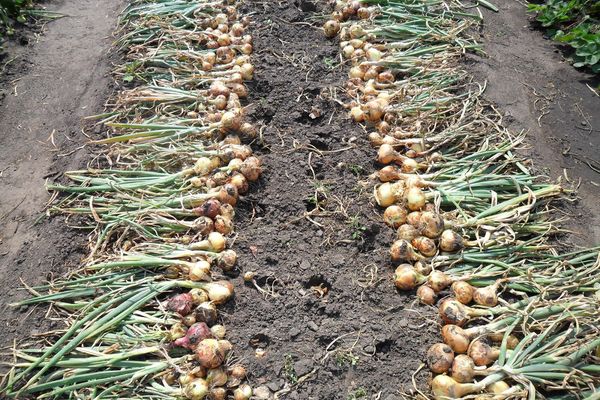
The arid summer heat will bring the ripening of the bulbs by 15-17 days, but cold August, on the contrary, will postpone the harvest for the same period of time, so the harvesting of onions can occur both at the beginning of the month and at its end.
When to harvest onions?
It is impossible to plan harvesting for one specific day, since the bulbs in the ground ripen unevenly and there is a risk of mixing good, dry turnips with unripe bulbs. Optimally, to allocate from 4 to 7 days for the whole process - this is also convenient because the onions, laid out for drying in the first place, will have time to dry out and make room for later collection. Since many gardeners like to experiment with different varieties of crops, the period when the onions ripen can be extended over a longer period. The maturity of the vegetable is determined, as usual by the appearance of the tops.
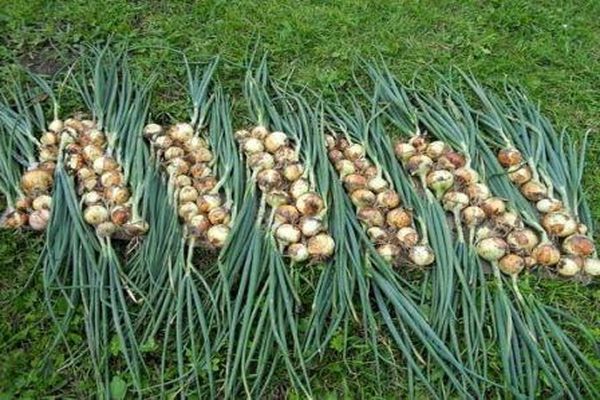
Winter onions that ripen in spring require more care when sorting, as they are rarely harvested in dry weather. The cultivation of such a vegetable is associated with many advantages - it is almost never attacked by pests and almost does not need additional watering. However, it is dangerous to overexpose it in the soil, especially if the weather is damp or it is raining - the winter crop willingly enters the second ripening cycle and releases new roots.
It is better to collect onions planted in spring when at least a week remains before the rainy season. This allows you to wait for all the onion turnips to ripen and calmly, without haste, dry them in the open air.
Danger of late harvest
Harvesting onions too early will inevitably doom the crop to a low preservation potential. When such onions are harvested from the garden and then stored in bulk, the bottom layer of the vegetable begins to sprout and rot, rapidly spreading moisture and fungus throughout the storage section. The only way to save the crop is to process the harvested bulbs for conservation immediately after harvesting.
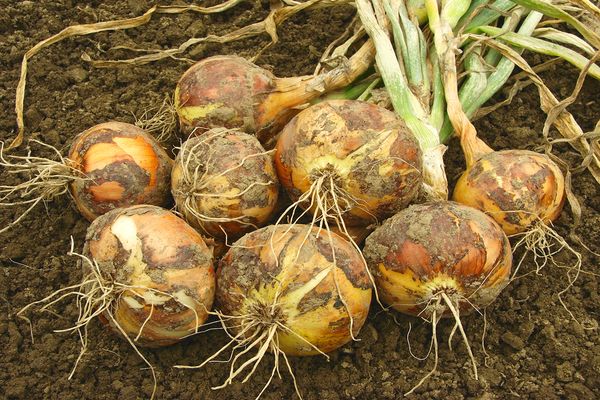
Signs of readiness for harvesting onions during the harvest season usually appear 75-80 days from the day of planting. Typically, the onion begins to dig when its feathers turn yellow and the soil is dry enough, but in the event of a threat of worsening weather, the ripening of the culture is artificially provoked. You can find out how to do this below.
When should you stop watering onions?
The first 55-60 days, the bitter vegetable grows rapidly and is filled with juice, and the remaining period, until the onion has to be removed from the garden, is set aside for the accumulation of useful elements, sucrose and other components of nutritional value.
At this time, when the growth of the bulb stops, it no longer needs a large amount of moisture and watering can be reduced, and then completely stopped.

Conventionally, the day when the soil under the crop is moistened for the last time is July 12th. If the summer was not very wet, by this time the yellowed onion arrows are laid to one side, and the visible neck of the bulb is already covered with several layers of dry scales and crunches under the fingers.
If rains are predicted starting from 60 days after planting the seedlings, then you should cover the garden with double cellophane or stretch a waterproof film over aluminum arcs, organizing a mobile, easily disassembled shelter.
How to accelerate the ripening of the bulbs?
Weather conditions, climate and the principles of caring for the crop during the growing period make their own adjustments in the standard time frame when you need to dig up onions. Often, a certain crop variety, planted without taking into account the characteristics of the region, does not have time to gain strength by the time the weather begins to deteriorate and the heads begin to rot right in the ground. To avoid this and speed up the ripening of the vegetable, small tricks will help that require minimal skill from the gardener:
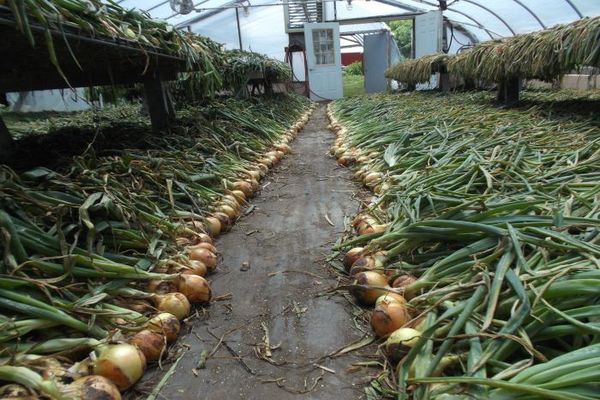
- Root trimming. To do this, use a well-pointed scapula, which is carefully brought under each onion, chopping up the roots and blocking the vegetable's nutrient channels.
- Partial pulling of the bulbs. This method requires caution, because when the onion is taken by the tops and pulled up a little, some of the feathers may break.It is undesirable to allow this, because bacteria enter the resulting damage, leading to rotting of the whole vegetable.
- Bare onion turnip. It is better to perform the operation by hand so as not to damage the scales-clad sides of the vegetable with the instrument. Each bulb is carefully released from the soil, exposing about a third, and left so for 5-8 days, until the vegetable dries.
Some growers go further and completely cut the tops on the eve of rains, so that the onions are dry and ready to be harvested as soon as possible. If the weather is very dry, and the feathers are cleaned of dust before removing them, then the method can be considered justified, although quite risky. If there is high humidity during the cutting of the tops, then the onion begins to rot by almost 100% and loses its storageability.
How to dig up onions correctly?
When it's time to harvest onions, a drying room or open-air areas should already be ready. The process technique may vary depending on moisture and soil type.
So, from loamy or moistened soil, pulling turnips by the feather is undesirable - for these purposes it is better to use a pitchfork. On the contrary, from dry and sandy loam soil, onions are perfectly extracted by hand.
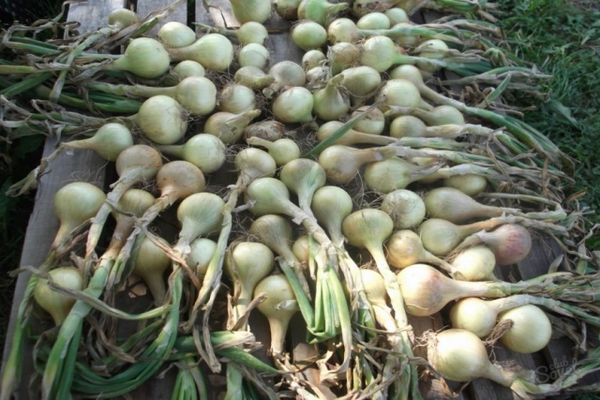
How to properly store dug onions? First of all, dry it thoroughly. Drying times will vary based on collection conditions. It is enough for a vegetable dug up in dry weather to lie down for 2-4 days.
Harvesting onions in the rain
Harvesting onions in the rain is complicated by the fact that it is very difficult to determine the maturity level of wet turnips and, together with good bulbs, unripe vegetables with a low-value, watery pulp structure can get into the general heap. Dry onion turnipsdug out in the rain, it is necessary only in closed, well-ventilated, warm rooms, laying vegetables on the floor in one layer and periodically, at least once a day, turning the vegetables from side to side.
You need to pick the bulbs from the dirt no earlier than it dries up and begins to crumble by itself. What to do if onions start to rot during drying? Spoiled turnips are immediately taken to the side and dried separately, and then immediately crushed for freezing or conservation.
Soaked onions are dried for at least a week, and it is advisable to store them in small wooden boxes.
How to properly dry onions in an apartment?
Cleaning for storage of seedlings from the garden goes through thorough drying, which is not always possible in a city apartment or a small summer cottage. If the harvest is not very large, then an ordinary gas oven is used for these purposes. Preheat the oven until about 40 C and fix the temperature regime at this figure. On a baking sheet, spread no more than 2 kg of onion at the same time and dry it in the oven for about two hours with the door half open. During this time, turnips need to be turned over 3-4 times.
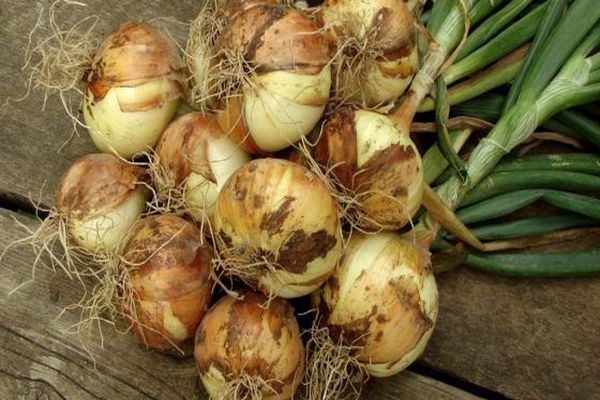
If in the kitchen it is possible to stretch the cross beams under the ceiling and hang the bundles of onions in this way, then drying can be carried out with the burners on. To tie the onion heads into bunches or weave them into wreaths, it is necessary to trim the feathers no closer than 4–5 cm to the head.
If drying is carried out without using heating devices, then the process is significantly extended and can take from 10 to 20 days.
How to store onions at home?
When the onion crop is removed from the garden and properly dried, it's time to organize the storage of the vegetable. In a private house, this point is not considered controversial, because on most household plots there is a cellar or a capital brick shed where you can store onions in bulk. But what about in city apartments, when every square meter counts?
There are three convenient ways to store your seedlings until next summer in a cramped home:
- Weaving with braids or wreaths.When it is supposed to tie onions in this way, the onion necks are trimmed leaving a long (5 cm or more) dry stem. After drying, a "pigtail" of a comfortable length is woven from the bulbs, which is tied to ceiling hooks (beams) in the kitchen or pantry.
- Storage in baskets or flat (up to 25 cm high) wooden boxes. In this way, onions are stored in a pantry or on an insulated balcony that does not allow moisture to pass through.
- Tying a bow in a stocking. They use clean nylon stockings, into which the onions are poured to the very top. The resulting "stalactites" are suspended from the ceiling, but they can also be stored on the wooden shelves of the pantry, laid in one row, knotted outward.
One of the most important conditions for long-term storage of onions is the moisture level, about 60% - this is the optimal indicator for keeping the culture... At values below 55%, the onion begins to dry out and it is necessary to organize additional air humidification in the room or pour more onion husks into the boxes with vegetables. At high values of the hydrometer, moisture from the container with onions must be "pulled back" by placing cardboard boxes with ash, husk of seeds, sawdust near the boxes.
Onion harvesting dates depending on regions
In each individual region, there are their own ripening periods for onion crops and, accordingly, their own periods when they are harvested:
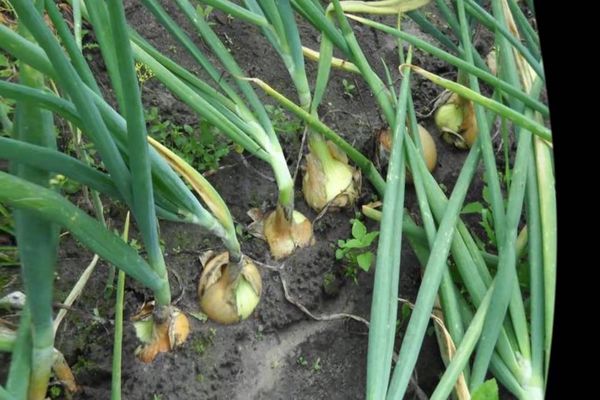
- harvesting of onions by gardeners of the Moscow region starts from July 25 and lasts until August 8-10;
- in the Urals, the vegetable stays in the soil until August 18–20;
- in the Leningrad region and in Siberia, the harvest dates fluctuate between 10-15 August.
The figures given, as it is easy to understand, are approximate values, the indents in which correspond to the individual characteristics of the current season. We must not forget about the characteristics of the soil - light soils dry out faster and accelerate harvesting, while heavy soils, on the contrary, hold moisture for a long time and retard the development of culture. At what period to harvest onions, you can understand only by taking into account all these factors.
Onion harvesting technology: results
So, the rules for harvesting onions from the garden are reduced to several main points. What you need to know about the timing when it is time to dig up the vegetable:
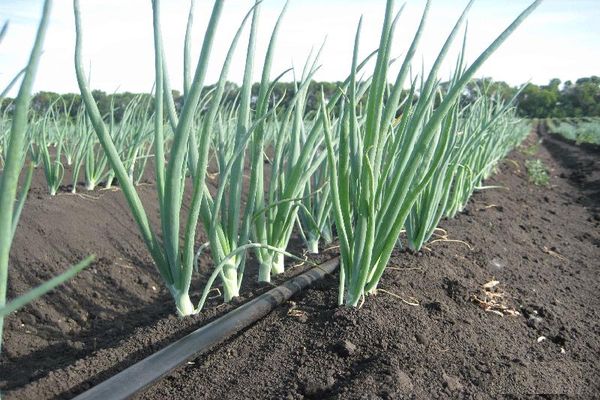
- Feathers “lay down” in 70–90% of the culture;
- more bulbs have withered lower leaves;
- the onion neck protruding above the soil is covered with dry scales and produces a crunch when pressed;
- the false stem has become soft;
- up to 20% of the roots have withered and died.
It is impossible to allow the turnips to begin to germinate again in the soil, therefore it is better not to wait for the tops of all vegetables to lodge, but to focus on a large percentage.
Before harvesting onions for storage, you need to thoroughly dry the vegetable, and carry out storage, in accordance with the actual possible conditions. During the winter, onions should be sorted at least three times, removing any softened or damaged vegetables.
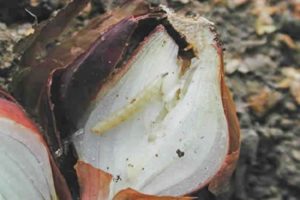
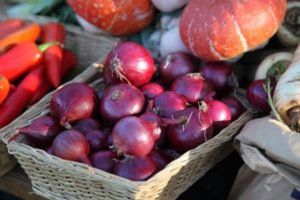

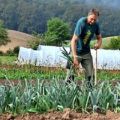
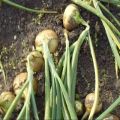

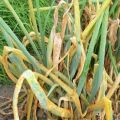
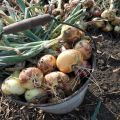

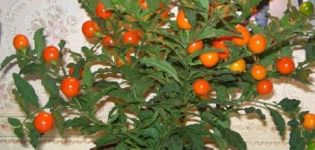
My grandmother always taught me that you need to remove the onions from the garden when the feathers are dry. For our region, it was the second half of August approximately. And to get a good harvest, we add BioGrow and are very happy with the result.